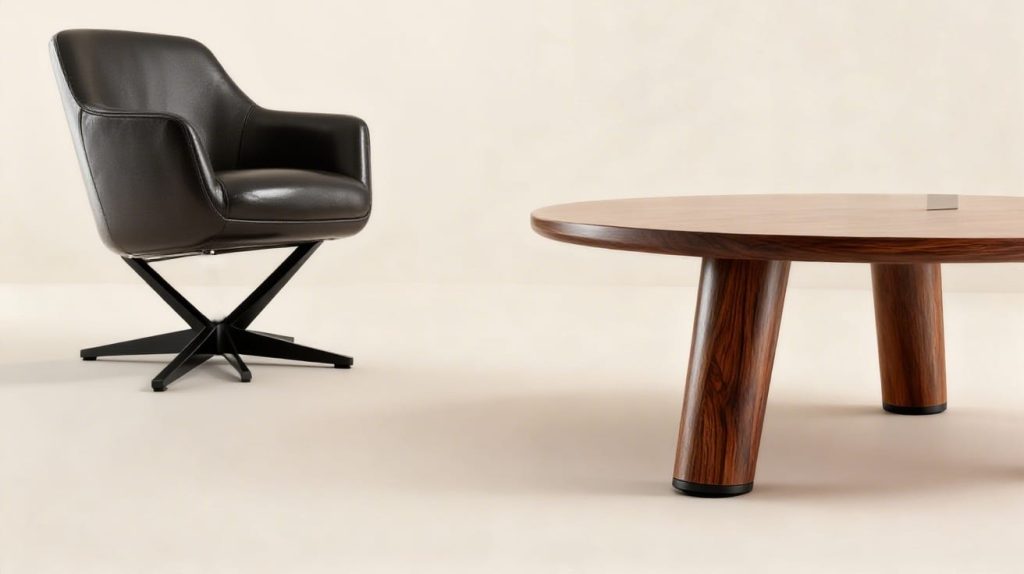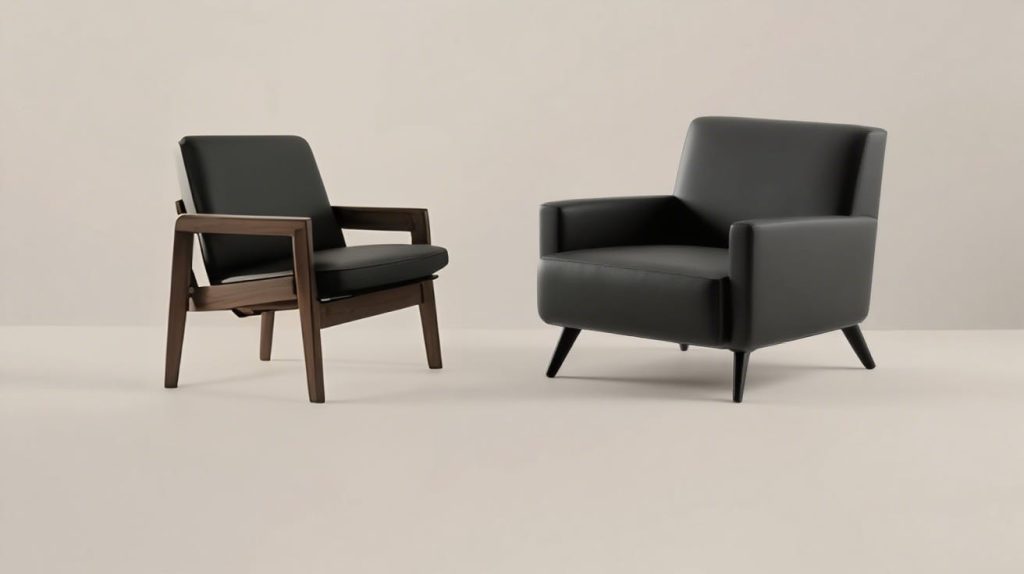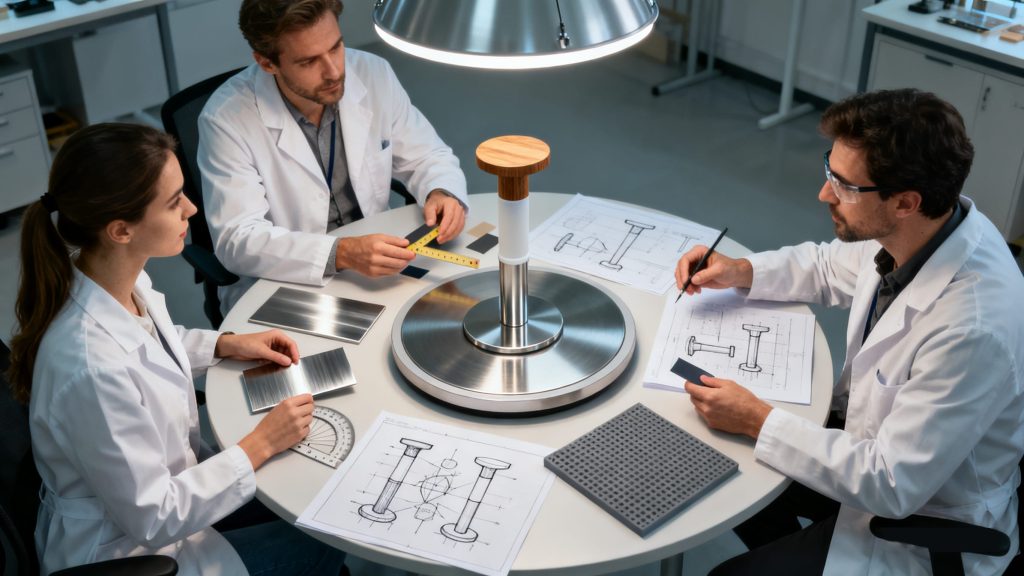Introduction
Welcome to the ultimate showdown of furniture legs! Whether you’re crafting a chic coffee table, a sturdy dining set, or a sleek sofa, the choice of furniture legs can make or break your design. Think of them as the unsung heroes of your furniture they support, elevate, and even add character to your pieces.

In this technical comparison, we’ll dive deep into three primary contenders: wood, metal, and plastic. Each material comes with its own set of characteristics, advantages, and design possibilities. From the rustic charm of wooden furniture legs to the industrial strength of metal options and the lightweight convenience of plastic designs, we’ll explore how these choices impact not just aesthetics but also functionality.
The global furniture market continues to grow, with increasing demand for stylish and functional furniture legs to support a wide range of designs.
So grab your measuring tape and let’s embark on this journey through furniture leg options that will help you make informed decisions for your next project. After all, choosing the right legs is not just about support; it’s about making a statement!
Understanding Furniture Legs: An Overview
Welcome to the world of furniture legs, where style meets stability! These unsung heroes of your favorite pieces be it a dining table, a chic sofa, or even an end table play a crucial role in both aesthetics and functionality. Let’s dive into the essentials!
Definition and Importance of Furniture Legs
Furniture legs are the foundational support structures for various furniture types, providing both stability and height. They ensure that your coffee table doesn’t become an accidental trampoline during family gatherings!
Common Types of Furniture Legs
- Table Legs: From dining tables to coffee tables, these come in various styles like tapered or square.
- Chair Legs: Often designed for comfort and style, chair legs can range from sleek modern designs to sturdy antique styles.
- Sofa Legs: The right sofa legs can elevate not just the couch but also the entire living room decor.
- Cabinet Legs: These often go unnoticed but are essential for ensuring your cabinets stand firm.
- Bed Frame Legs: Essential for support, they can also add a touch of flair to your bedroom setup.
Role in Design and Functionality
The choice of material and design for your furniture legs can drastically affect not just the look but also the usability of your furniture. For instance:
- Wooden furniture legs: Bring warmth and elegance, perfect for traditional settings.
- Metal furniture legs: Offer industrial chic vibes while providing unmatched strength.
- Plastic furniture feet: Lightweight and versatile, they are perfect for those who prioritize cost-effectiveness without compromising style.
Did you know? The right choice in furniture legs can enhance not only the aesthetic appeal but also ergonomic comfort. A well-designed leg can make all the difference between a piece that looks good and one that feels good!
No matter what type you choose be it heavy-duty industrial legs or decorative mid-century options the right pair of furniture legs can transform your space from drab to fab! So, whether you’re looking to replace tired old couch feet or upgrade with custom solutions, understanding these fundamentals will help you make informed decisions.
Wooden Furniture Legs
When it comes to furniture legs, wooden options are often the classic choice that combines durability with aesthetic charm. Think of them as the well-tailored suit of the furniture world always in style, no matter the decade!

- Characteristics of Wooden Furniture Legs: Typically made from hardwoods like oak, maple, or walnut, wooden legs offer a solid foundation for your favorite pieces. They can be crafted into various shapes and sizes, from tapered to square, adding character to any design.
- Advantages of Wood as a Material: Wood is not just about looks; it’s also incredibly versatile. It can be stained or painted to match any decor style from modern minimalism to rustic charm. Plus, it’s a renewable resource, making it an eco-friendly option!
- Common Types of Wood Used in Furniture Legs: Some popular choices include:
- Oak: Known for its strength and durability.
- Maple: Offers a smooth finish and is highly resistant to wear.
- Pine: A budget-friendly option that provides a warm aesthetic.
- Design Versatility and Aesthetic Appeal: Wooden legs can effortlessly transition between styles. Whether you’re going for mid-century modern with tapered legs or something more industrial with chunky designs, wood has you covered!
- Durability and Maintenance Considerations: While wood is strong, it does require some TLC. Regular polishing and avoiding excessive moisture will keep those beautiful table legs looking fresh. Remember, a little care goes a long way in preserving their charm!
Did you know? Wooden furniture legs can often be replaced easily if damaged just unscrew the old ones and screw on new replacements! This makes them not only stylish but also practical.
Metal Furniture Legs
When it comes to furniture legs, metal is the heavyweight champion of durability and style. Whether you’re looking for table legs, chair legs, or even those sleek sofa legs, metal offers a strength that wood and plastic simply can’t compete with.

Characteristics of Metal Furniture Legs
Metal furniture legs are known for their robust construction and modern aesthetic. They come in a variety of finishes, from shiny stainless steel to warm brass tones, making them suitable for both industrial and contemporary designs.
Types of Metals Commonly Used
- Stainless Steel: Great for heavy-duty applications due to its resistance to rust.
- Brass: Offers a vintage appeal and is often used in decorative furniture legs.
- Iron: Known for its strength and stability, often found in antique furniture legs.
Benefits of Metal: Strength and Stability
The primary advantage of using metal is its incredible strength. This means you can create furniture that can withstand the test of time or at least the test of your kids jumping on the couch! Metal legs also provide better stability compared to their wooden counterparts, especially when it comes to adjustable furniture legs or heavy-duty applications.
Key Takeaway: Metal furniture legs are ideal for both aesthetic appeal and structural integrity. They’re perfect if you want your dining table legs or coffee table legs to be both stylish and sturdy!
Aesthetic Trends in Metal Leg Designs
The design world has embraced various trends in metal leg styles. From hairpin furniture legs that evoke mid-century modern vibes to tapered designs that add a touch of elegance, there’s no shortage of options. These styles not only enhance the visual appeal but also complement various decor themes.
Caring for Metal Furniture Legs
No one wants rusty couch feet! To keep your metal furniture looking pristine, regular maintenance is key. Simple cleaning with a damp cloth can prevent dust buildup, while applying a protective coating can help ward off rust especially important if your metal is exposed to moisture.
Plastic Furniture Legs
Ah, plastic furniture legs the unsung heroes of the furniture world! Often overlooked, these lightweight champions are not just about saving a few bucks; they bring a whole lot of functionality and style to the table (literally!).
- Characteristics of Plastic Furniture Legs
- Plastic furniture legs come in all shapes and sizes, from sleek and modern to quirky and decorative. They’re like the chameleons of furniture legs, effortlessly blending into any design scheme.
- Advantages: Lightweight and Cost-Effective Solutions
- One of the biggest draws? Their weight! Plastic legs are incredibly light, making them easy to move around. Plus, they’re generally more affordable than their wooden or metal counterparts. This means you can save some cash for that fancy coffee table you’ve been eyeing!
- Diverse Styles Available in Plastic Designs
- From adjustable furniture legs that can accommodate uneven floors to decorative options that add flair to your sofa or dining table, plastic legs offer endless possibilities. Think of them as the Swiss Army knife of furniture components versatile and ready for anything!
- Sustainability Considerations in Plastic Manufacturing
- With sustainability on everyone’s minds these days, it’s worth noting that many manufacturers are now producing eco-friendly plastic options. This means you can have your stylish chairs without feeling guilty about Mother Earth.
- Cleansing and Care for Plastic Materials to Ensure Longevity
- While plastic is durable, it does require some TLC. Regular cleaning with mild soap and water will keep those chair legs looking fresh. Just remember: no abrasive cleaners! Treat them like your favorite shirt gentle care goes a long way.
According to recent trends in design reports by top interior designers across America, plastic furniture legs are becoming increasingly popular due to their versatility and affordability!
In conclusion, when choosing your next set of furniture legs, don’t underestimate the power of plastic! They offer a blend of functionality, style, and affordability that can elevate any piece of furniture. So whether you’re upgrading your dining table legs or sprucing up some antique chair legs with modern touches, consider going plastic!
Ready to explore more about custom solutions for your projects? Let’s dive deeper into how we can help you achieve your vision!

A Comparative Analysis: Wood vs. Metal vs. Plastic
When it comes to furniture legs, the choice of material can make or break your design vision. Let’s dive into a comparative analysis of wood, metal, and plastic furniture legs to see how they stack up against each other in terms of strength, aesthetics, and current trends.
Categorizing Based on Strength and Durability Needs
Strength and durability are paramount when selecting replacement furniture legs. Here’s a quick rundown:
| Material | Strength Rating | Durability |
|---|---|---|
| Wood | Moderate to High | Good (depends on type) |
| Metal | High | Excellent (rust-resistant options available) |
| Plastic | Low to Moderate | Fair (can degrade over time) |
Aesthetic Considerations Across Different Materials
The visual appeal of your furniture legs can significantly influence the overall look of your piece. Here’s what you should consider:
- Wooden Furniture Legs: Perfect for a warm, classic touch think mid-century modern or antique styles.
- Metal Furniture Legs: Ideal for an industrial vibe; hairpin and tapered designs are trending in contemporary decor.
- Plastic Furniture Legs: These offer flexibility in design but often lack the luxurious feel of wood or metal.
Cultural Trends Influencing Material Choices in Design Reports
The latest trends show a fascinating shift in preferences influenced by sustainability and functionality:
According to recent design reports, consumers are increasingly leaning towards sustainable materials. This means that while wood remains a favorite for its aesthetic charm, recycled metals and eco-friendly plastics are gaining traction.
This cultural shift is not just about looks; it’s about making choices that resonate with environmental consciousness. Designers are now opting for materials that tell a story whether that’s reclaimed wood from old barns or metals sourced from sustainable practices.
In summary: each material has its strengths and weaknesses when it comes to furniture legs. Wood offers timeless beauty, metal provides unmatched strength, and plastic presents affordability with versatility. Your choice will depend on your specific needs be it durability for heavy-duty applications or aesthetic appeal for decorative pieces.
If you’re still on the fence about which material to choose for your next project, consider how these factors align with your design goals and customer expectations!
The Role of Customization in Choosing the Right Material for Your Project
When it comes to furniture legs, customization is the secret sauce that can elevate your project from drab to fab. Think of it as tailoring a suit off-the-rack might fit, but custom-made is where the magic happens. Let’s dive into why customization matters and how it can transform your furniture design.
- Understanding OEM Solutions for Unique Requirements: Original Equipment Manufacturer (OEM) solutions allow you to specify exactly what you need. Whether you’re looking for heavy-duty furniture legs for a commercial dining table or sleek, modern furniture legs for a minimalist sofa, OEM options ensure that your specifications are met without compromise.
- Collaborative Design Process with Manufacturers: Working hand-in-hand with manufacturers opens up a world of possibilities. You get to influence everything from the material choice be it wood, metal, or plastic to the style, like those trendy hairpin or tapered designs. This collaboration often leads to innovative solutions that standard products just can’t provide.
- Case Studies: Successful Implementations with Custom Features: Take a look at successful projects where customization played a pivotal role. For instance, a high-end restaurant might opt for bespoke metal furniture legs that not only match their aesthetic but also withstand heavy traffic. Or consider a boutique hotel using custom
- designed to echo their vintage theme while ensuring durability and stability.
Tangible Takeaway: Always consider how customizable options can enhance both functionality and aesthetics in your furniture projects. Don’t just settle for off-the-shelf solutions; explore how tailored designs can meet your specific needs and elevate your brand’s identity!
Understanding OEM Solutions for Unique Requirements
Collaborative Design Process with Manufacturers
When it comes to furniture legs, OEM (Original Equipment Manufacturer) solutions play a crucial role in meeting unique requirements. A collaborative design process with manufacturers ensures that the final product not only meets aesthetic standards but also functional and durability needs.
1. Initial Consultation and Requirements Gathering
The first step in this collaborative process is an initial consultation where designers and manufacturers discuss the specific requirements of the furniture legs. This includes factors such as load-bearing capacity, environmental resistance, and aesthetic preferences. For example, if a designer is looking for furniture legs that can withstand heavy use in a commercial setting, they might opt for metal legs with a high tensile strength.
2. Prototyping and Testing
Once the requirements are gathered, manufacturers create prototypes of the furniture legs. These prototypes are then tested for various factors such as durability, stability, and appearance. For instance, plastic furniture legs might be tested for UV resistance to ensure they do not degrade under prolonged sunlight exposure.
3. Iterative Design Improvements
Based on the testing results, the design is iteratively improved. This might involve changing the material composition, altering the shape, or adding new features. For example, if the initial plastic legs are found to be too flexible, the manufacturer might suggest adding a metal core to increase rigidity.
Case Studies: Successful Implementations with Custom Features
Several case studies highlight the success of collaborative design processes in creating unique furniture legs.
1. Case Study: Modern Minimalist Desk with Metal Legs
A furniture designer wanted to create a modern minimalist desk with sleek metal legs. The designer collaborated with an OEM manufacturer to develop legs that were both lightweight and strong. The final product featured aluminum legs with a brushed finish, providing a contemporary look while ensuring durability. The desk became a best-seller in high-end furniture stores.
2. Case Study: Rustic Wooden Table with Custom Plastic Legs
Another example is a rustic wooden table designed for outdoor use. The designer needed legs that could withstand harsh weather conditions without compromising the rustic aesthetic. The manufacturer suggested using high-density plastic legs with a wood-grain finish. These legs were tested for UV resistance and water resistance, ensuring they would last for years in outdoor environments. The table received positive reviews for its durability and appearance.
3. Case Study: Industrial-Style Sofa with Reclaimed Wood and Metal Legs
In a third case, a designer aimed to create an industrial-style sofa with reclaimed wood and metal legs. The challenge was to combine the rustic charm of reclaimed wood with the robustness of metal. The manufacturer developed a hybrid leg design, where reclaimed wood was mounted on a metal frame. This design not only met the aesthetic requirements but also provided the necessary support for the heavy sofa. The product was well-received in both residential and commercial settings.
Conclusion
Understanding OEM solutions and engaging in a collaborative design process with manufacturers is essential for creating furniture legs that meet unique requirements. By working closely with manufacturers, designers can ensure that their furniture legs are not only functional and durable but also aesthetically pleasing. The case studies provided demonstrate the success of this approach in various contexts, highlighting the importance of collaboration in achieving the desired outcomes.
